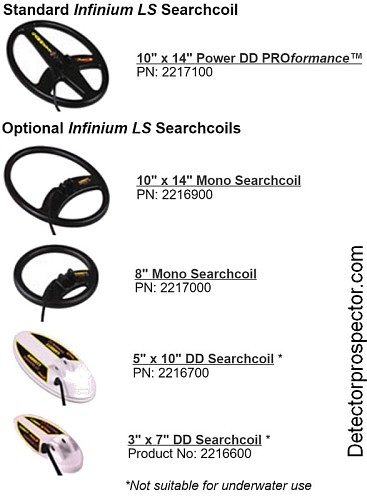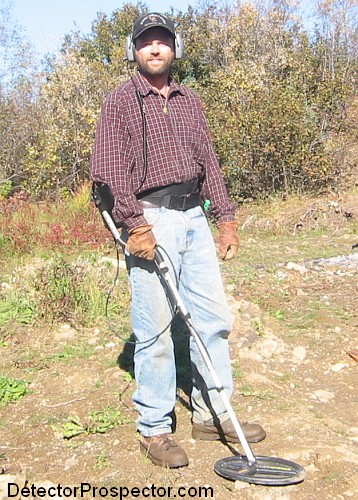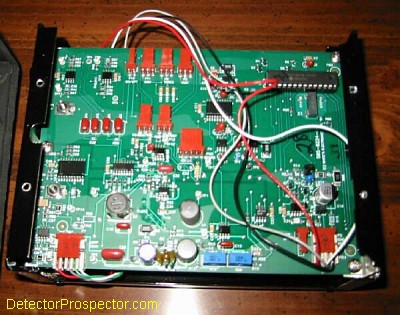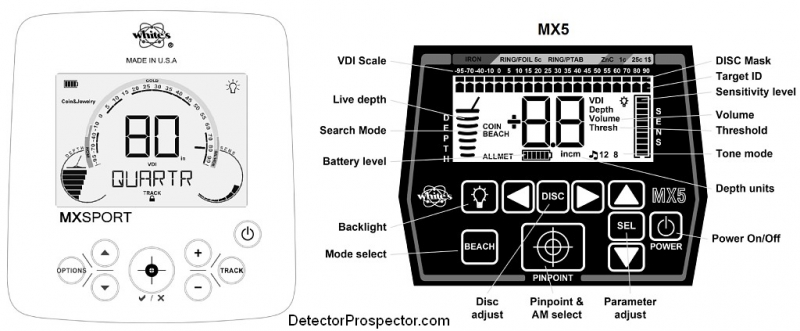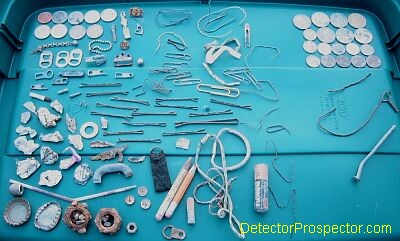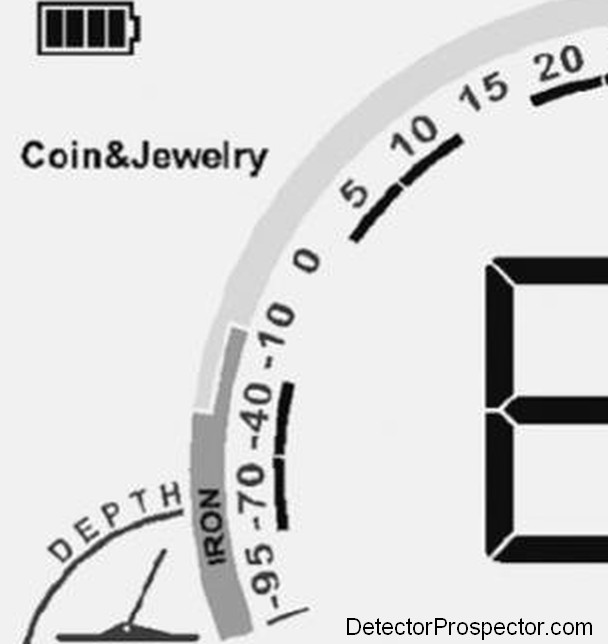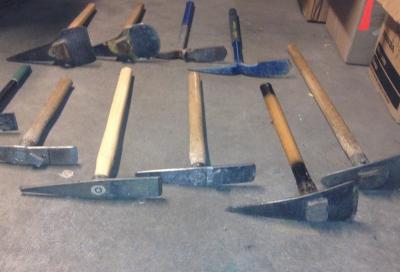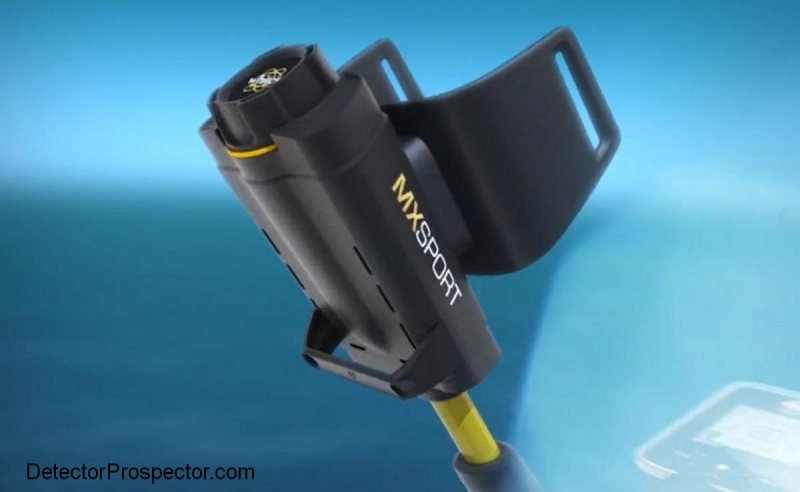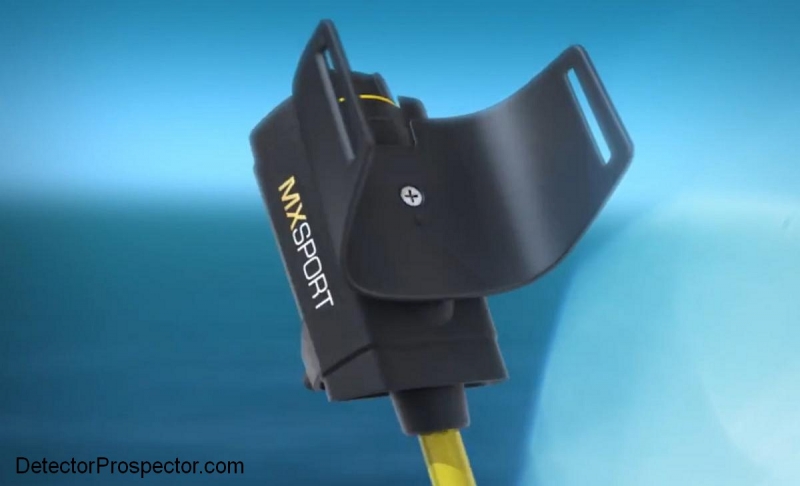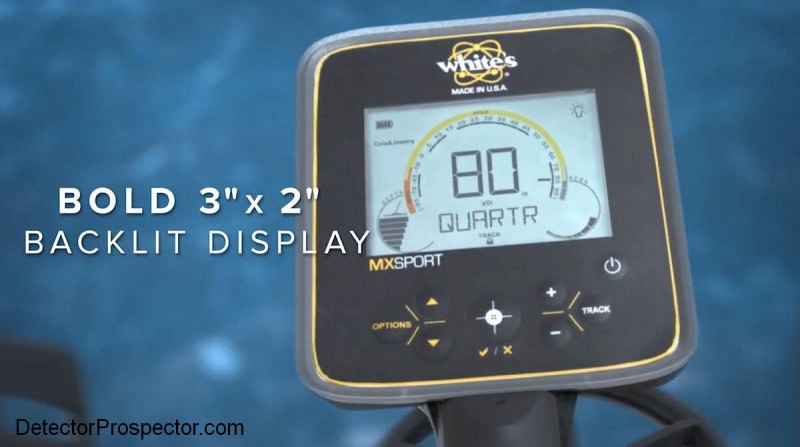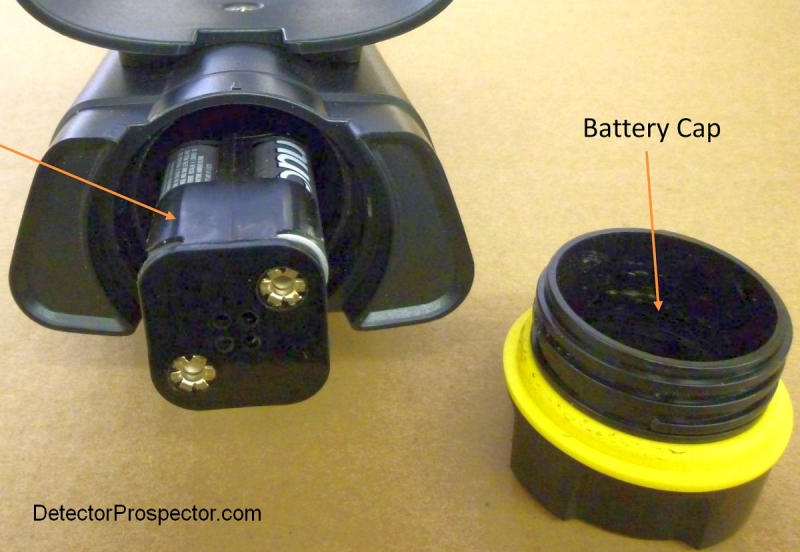-
Posts
19,756 -
Joined
Content Type
Forums
Detector Prospector Home
Detector Database
Downloads
Everything posted by Steve Herschbach
-

Tesoro Silver uMax Pinpointer Conversion
Steve Herschbach replied to Steve Herschbach's topic in Compass, D-Tex, Tesoro, Etc.
Very nice, clean looking unit - good work! I still think there is a market for "Super Pointers" similar to this if any of the factory folks would be willing to take a chance. Be a no-risk proposition for Tesoro in particular with no research or development costs. Just off the shelf stuff put together right. A short internal cable would be sweet. Thanks for posting, I really like that. -

Infinium Ls / Detecting Gold Question
Steve Herschbach replied to Oregon Jim's topic in Garrett Metal Detectors
There are four accessory coils available for the Infinium, but coil size or type is not the issue so much as pulse delay and a circuit driven by eight AA batteries. Going to a smaller coil, which I have done, only boosts sensitivity by a small amount and you lose depth and ground coverage. The 8" mono has depth as good as the 14" x 10" DD but does not cover ground as well. It does have good on edge sensitivity and is much lighter, so a good option. There is a lot to like about the Infinium. A ground balancing PI for under $1100, and I really like the ability to chest or hip mount it plus waterproof to 200 feet. I wish the ATX had been left in the Infinium box. Coils are very reasonably priced, more like VLF coils than PI coils. It handles ground and hot rocks very well, but like the TDI SL lacks serious punch. Here are 4.11 ounces of gold specimens I found at Moore Creek, Alaska in 2003 with my Garrett Infinium.... -

Infinium Ls / Detecting Gold Question
Steve Herschbach replied to Oregon Jim's topic in Garrett Metal Detectors
Great, and welcome to the forum! Don't let it put you off the Infinium. It is a great detector but like all good for some things and not so good for other things. Just have to use it for what it is best at. Do follow and read my links if you have the chance - lots of great Infinium information there. -

Infinium Ls / Detecting Gold Question
Steve Herschbach replied to Oregon Jim's topic in Garrett Metal Detectors
This is such a common question I finally made a thread just about it at http://www.detectorprospector.com/forum/topic/1559-why-wont-my-detector-find-a-bottle-full-of-small-nuggets-or-a-gold-chain/ All detectors have a cut off point for small gold. The Garrett Infinium is a ground balancing pulse induction detector and an early version at that. As such it is very weak on small gold items. And as my new thread explains, there is minimal to no additive effect when putting small gold in a bottle. I did well with my Infinium finding larger gold but I would not much bother using one unless I knew nuggets were running a gram or larger in the area I wanted to hunt. There is not much benefit in running the Infinium versus a good VLF unless the hot rocks are really bad. The Infinium can deal with those better than a VLF, but since it does also give up small gold sensitivity you have to decide which issue is most important. -
This subject comes up so often it is time to get it into its own thread so I can just link to it in the future. It is best to think of metal detectors made for prospecting as "nugget detectors" as that is the truth of the matter. Nuggets have some size to them. Metal detectors are electromagnetic devices, and as such can detect items that are conductive and non-magnetic, like gold, or non-conductive but magnetic, like magnetite. Or both, like metallic iron. When dealing with gold you are dealing only with conductivity. The more conductive the mass, the easier it is to detect. In general what this means is bigger is better. Any detector has a limit to how small an item it can detect. Here is the kicker. Multiple undetectable targets do not add up to create a detectable target. I do not know how many times I've seen or been told of people throwing a vial of small gold on the ground and running a detector over it and declaring the detector will not find gold because it does not pick up the vial of gold. Or people thinking the detector has a problem. Let us say that on a scale of 0 - 10 zero represents an undetectable piece of gold, and 10 one that really beeps. 0 + 0 + 0 + 0 + 0 still equals zero. So lots of tiny gold is just as undetectable as a single piece of tiny gold. You need a single conductive mass. Fine gold usually has a coating, and putting a bunch of fine gold in a vial still results in little or no signal. If the gold is super clean and packed tightly you will get a weak signal. Melt it all together, and now it goes beep. Another way to look at it is take some fine gold and pour it in a pile. Get a multimeter and test your little pile of gold for conductivity. It is hard to get much current if any through a loose pile of gold. So bottom line is you might have 5 ounces of fine gold right under your feet, and you will walk right over it with your metal detector. Rich gold ore where the gold is finely dispersed in the rock will be hard to detect or undetectable. Wiry or spongy masses of gold are hard to detect. Jewelry hunters run into this when trying to detect lost necklaces. A fine chain is very hard to detect as each link is undetectable and the connection between the links is poor enough the signals does not add up to much. Often all you can detect is the clasp. Rings even display this issue if the weld breaks. A complete ring really gives a great signal. Break the ring, it will be very hard to detect. Now once an item is detectable, it does add up. 10 + 10 = 20 so two large nuggets in the same spot are easier to detect than each by itself. If each link in the gold chain can be detected, then it will add up into a more detectable target. A fun trick with target id detectors is to tape 5 nickels together and run them under the coil. They will read as 25 cents! It's hard enough to detect loose items in air tests. It becomes impossible in saltwater.
-
Is the MX Sport a suped up MX5? My best guess is this is the higher end MX5 version that was planned then put on hold. Some history here. The White's MXT was designed by a team lead by famed engineer Dave Johnson, who White's hired specifically for the project. The GMT was an early offshoot from that project in 2001 with the MXT coming shortly after in 2002. See the MXT Engineering Report for details. In my opinion the MXT was one of the best all around detectors ever designed, and probably White's most popular ever. It is a bit unique in that it is a digital machine underneath, but controlled through old fashioned knobs giving it an old style analog feel. The combination of simplicity and power was a winner and White's has used that original work by Dave for 15 years now, with various derivative machines like the M6 or SST. The White's M6 is basically a stripped down MXT, but it added a seven tone id mode that the original MXT lacked. The most tones you got on the MXT was two tones in Relic mode. The MXT Pro then basically added the seven tone feature, backlight, and ground grab button to the MXT. Many people still liked the original MXT at a slightly lower price, so it continues to be produced. A special Sierra model called the SST was also produced that is just an M6 in full time tracking mode. The problem at the end of the day is the main circuit board of the MXT. White's really hung in there with same metal box used in various models for about 20 years. The MXT box is 6.3" long x 5" wide and the board takes up every bit of it inside. Lots of wasted space on that board. The is lots to like about that old design; well balanced, easy control layout, does not fall over when laid down. But the world moved on. Cell phones got smaller and so did other metal detectors. White's needed to learn how to make machines smaller and more compact. White's set about trying to miniaturize the MXT circuit board and started fresh with a new circuit built from the ground up. The idea was to try and duplicate the MXT as much as possible in a smaller fully digital design and to even add features and capability. For various reasons a mid-range version called the White's MX5 was released first. It offers MXT like performance in a lighter weight package. I really liked the MX5 overall but White's lost me with one little thing - the MX5 is locked into full time ground tracking. I am getting less concerned over that issue as modern tracking systems improve, but I stated in various places I would wait for the next version that added the ability to lock and ground grab. Interestingly at this point in time, the MX5 had a little issue with tones on release that had to be fixed. It had to do with the machine being designed with extra capability for down the road. Carl Moreland worked for White's at the time and had this to say about the MX5 tone issue "The MX5 was designed to use stereo audio for mixed mode in a higher-end model (which was canceled), so in the MX5 we connected the audio channels together. This caused a glitch in the micro that wasn't noticed in testing, so the easy solution was to remove R67." It appears that higher end project was not canceled but delayed, or canceled and brought back to life. Part of this may have been the introduction of the White's Treasuremaster last spring and the possibilities the new housing represented. In any case, we know the MX5 circuit board had the ability to run in Mixed Mode and the new MX Sport has the Relic mode (mixed mode) missing in the MX5. There is also the tone evidence. The MXT Pro has 1, 2 or 7 tones. The MX5 has 1, 2 or 8 tones. The MX Sport has 1, 2, 4, 8, and 20 tones and so appears to be an enhanced version of the MX5. The real evidence that the MX Sport is a beefed up MX5 is the target id numbers and notch discrimination scheme. The MX5 and MX Sport are identical in this regard. In fact, studying the MX5 Owner's Manual offers some insight into the MX Sport discrimination system. OK, so why all the obsession over this? Having Googled away on MXT vs MX5 I came to a couple conclusions. First, people think the MX5 performs just as well if not better than the MXT for depth, and it has a faster processor. The main criticism is in the audio. Some like the MXT faux analog audio as compared to the more digital sounding MX5. I can promise you right now that sort of thing is a personal preference item. Audio jives with you or it does not, and only using a machine can tell you what works best for you in that regard. The other big complaint was lack of ability to lock the ground tracking. My guess - and again I am only making educated guesses folks, is that the MX Sport is the full blown MX5 circuit unleashed with the mixed mode and other extra features enabled, stuffed into a beefed up Treasuremaster style housing. That said it is likely to have great performance and the main issue for many people is likely to be in the audio as compared to the old MXT. However, Paul's issue with M6 ferrous/non-ferrous audio is not going to be duplicated here except by chance as the tone schemes are different. Well, have a couple chores to attend to but I have more thoughts to add both on the notch system and the tone scheme, so check back later. I am really liking the look of the MX Sport, my only puzzlement being over why, with all this redesign, did White's not redesign for a lower power four AA system. Yes, it can be done without giving up depth - depth and AA count are not related in simple VLF machines. The MX Sport at 4 lbs outweighs the Garrett AT Pro by a solid pound, and part of that is in double the battery weight. I do think the MX Sport is going to have a beefier more "adult" feel to it - the AT series all remind me of the Ace 250, which while a great machine has a kids feel in it's construction. The MX Sport will be better balanced by far with the underarm battery compartment so there is that at least. Balance is as important as weight and so maybe they needed that weight out back to balance the 10" DD coil up front. Another possibility is this housing will be used for many other models going forward and the eight AA system is needed more for use in other machines than this particular one. If that is the case it is just a cover all bases in one housing decision. Bottom line is the MX Sport is still best thought of as an MXT crammed into a more compact package, as there is no doubt in my mind the MX5 circuit board was designed with the MXT fully in mind. But people expecting something that acts exactly like an MXT just in a different package should know there will probably be differences, many pretty obvious, but some more subtle. At the end of the day this is the closest thing to a waterproof MXT you are going to see. Whether that is good enough only time will tell.
-

Makro Gold Racer vs Nokta FORS Gold+
Steve Herschbach replied to tvanwho's topic in Nokta / Makro Metal Detectors
Well I have already run them both. I have no plans for a this versus that review of the two other than what I am typing right now. If you have any other questions you will have to ask. I doubt you are going to hear from many people that will have used both models. The Nokta FORS Gold+ is built more like a Minelab for those that prefer that type layout. The Makro Gold Racer is more the standard design these days. The FORS Gold+ at 19 kHz is less edgy than the Gold Racer at 56 kHz which performance-wise makes it a bit more practical for detecting in extreme trash. The 56 kHz Gold Racer is hotter on tiny stuff but you do not always want that when hunting around an old cabin site or a trashy park. Performance-wise the closest competitor machine to the FORS Gold+ is the Fisher Gold Bug Pro. The closest competitor machine analogous to the Gold Racer is the White's GMT. Depth on larger stuff is near the same with both. The Gold Racer is hotter on tiny gold, but also more reactive to hot rocks and tiny trash. Typical frequency trade off, no free lunch. Which is better? Depends what you want. Keith Southern and I have been using both. Keith found the Gold Racer too hot for working heavy ferrous trash, his specialty. I am more interested in the Gold Racer hots for finding tiny gold my GPZ 7000 misses. So I am keeping my Gold Racer and letting my FORS Gold+ go, and it is going to Keith. For Keith the FORS Gold+ is a real winner for what he does. The Gold Racer is a winner for what I do. Anyone used to running a GMT or Gold Bug 2 in all metal mode with take right to a Gold Racer in all metal mode. The Gold Racer disc modes are trickier. They are great in milder ground and less trashy areas, but as you crank up the hot rocks and the ferrous trash the disc modes get harder to tame, a side effect of the extreme sensitivity and fast recovery time. The FORS Gold+ is the Ford truck, great all around performance. The Gold Racer is the Chevy Corvette - sports cars are hot but use them for the wrong thing you will crash and burn. You already have an MXT and Gold Bug 2 Tom. These other detectors will not add anything substantial in capability that you do not already have. Sounds like you you just have the "I wanna new detector" bug so common in our circles. I for one really understand that feeling. The never ending quest for the perfect machine that always ends in vague disappointment, which can only be cured by another new machine! -
Right now the White's MX Sport User's Manual is the source of all wisdom, and nothing there. I am sure you know that was an early version of the manual for the FCC and so there could be things we will not know until the final version. I don't see anything about shutting off the "guess" system. But if White's is thinking international (and they should be) it should have the ability to be shut off or changed. There could also possibly be a U.S. version and an international version of the machine, like with the AT Pro. Silly that it is not one character longer anyway. Would it have cost that much more to have it say QUARTER? Be of more use for system warnings or alerts (low battery, overload, etc.). My often wished for alarm clock display could go there!! On the MXT Pro the "guesses" change from coin type guesses to relic type guesses in Relic mode, so it reads "button" or "bullet" or "buckle". No indication in the manual about that either. Never had much use for any of that type stuff myself but easy to ignore.
-

Coin Detecting With Garrett ATX
Steve Herschbach replied to Rich from RI's topic in Garrett Metal Detectors
The bad news? You really should not use a PI unless as a rule digging all targets is acceptable. Areas with dense junk will defeat most PI operators. Now the better news. Ground balancing PI (GBPI) detectors do offer some options. The Minelab PI detectors and the Garrett ATX do offer a ferrous reject option that works on most shallow ferrous stuff. The Minelab can blank shallow ferrous items, and the ATX can make a grunt or buzz type sound on shallow ferrous. Neither method works on deep stuff, and the accuracy on shallow stuff is just OK at best. You will stil dig plenty of iron with this method. All ground balancing PI detectors also split targets into two categories, those above the current ground balance setting, and those below the current ground balance setting. These are indicated by the tone. On the Garrett Infinium, Garrett ATX, and Minelab PI detectors you get either a hi-lo dual tone, or a lo-hi dual tone. The White's TDI series gives either a simple hi tone or a lo tone. A hi-lo or hi tone basically means a low conductive or small ferrous items. A lo-hi or lo tone means a high conductive or large ferrous item. On one hand (hi-lo or hi tone) you get all manner of small ferrous stuff, aluminum, most gold and platinum items, U.S. nickels, and maybe zinc pennies. The break point is around zinc penny, depending on ground balance setting. On the other hand (lo-hi or lo tones) you get large ferrous stuff, copper and silver coins, and very large gold items. The tones work to full detection depth. The White's TDI is the only GBPI that takes advantage of this tone scheme by having a tone selector switch to chose one or the other or both types or targets to be accepted. The problem is this is not really a discrimination system but an accident of the ground balance system. Not only does the ground balance setting affect the tones but other factors like pulse delay on the TDI and timings on the Minelabs. The pulse delay setting on the TDI and "discrimination" setting on the Infinium/ATX in simplest terms adjusts the sensitivity to small or low conductive stuff. By increasing the pulse delay on TDI or Infinium/ATX disc setting you cause overall sensitivity to small ferrous items and small aluminum or small gold to be reduced. So yes, you need lots more hours, and you have to make strategic decisions. A person wanting to dig modern copper, silver and clad coins can just dig lo-hi or lo tones and miss most small ferrous trash and aluminum trash, plus almost all gold or platinum items. in Europe tiny cut or thin silver coins can also act as low conductive because of their very small size. For gold you have to dig hi-lo or hi tones, and also get all manner of tiny ferrous stuff and aluminum. And miss all the other stuff, including large gold nuggets and maybe larger gold coins. The tone scheme results are about the same for all the GBPI detectors. The photo below is results with an Infinium but would be about the same with others. Items on the left are hi-lo dual tone or TDI high tone. Items on the right are lo-hi dual tone or TDI lo tone. This was a playground area, and obviously digging only lo tones will eliminate almost all trash. Great if you want the coins but not great if you want the jewelry. Almost all jewelry will go hi-lo tone except silver jewelry. The coins on the left are U.S. nickels and a zinc penny, all low conductive. By using tones and the disc settings and the shallow ferrous settings together you can get pretty good at it. Or not. It is pretty much the realm of the real pro detectorists and a real hard way to start out detecting. You either have the patience for it or you do not, and no matter what you are going to dig a lot of junk. Welcome to PI detecting. See Coin Detecting with the Garrett Infinium and Beach Detecting with a Minelab GP 3500 for reference. Also White's and the TDI Coin settings. There is a great informative spreadsheet for TDI settings and how responses on bullets and buttons change with ground balance and pulse delay setting. And since you have an ATX see Gold & Silver with Garret ATX -
OK, here is a major difference between the MXT Pro and MX Sport. At least near as I can tell based on preliminary information. The MXT Pro has various programs and tone schemes, but only one discrimination control of note. A single turn knob. In some modes setting the knob higher causes items lower than the setting to be ignored. In Relic mode, the knob setting determines where the tone switches, or breaks, from low tone "rejected" to high tone "accepted". The MXT Pro has no ability to notch out or reject a range in the middle of the conductive range except for a little known feature on early MXT (non-Pro) models, whereby the placing the trigger switch forward in Coin mode activated a preset "pull tab notch" setting. You do of course have the ability to hunt by preset tone options which can serve the same purpose. The MX Sport appears to have no variable control but instead uses a notch or bin system based on target id segments similar to many modern digital detectors. There are twenty notches or bins, 16 non-ferrous and 4 ferrous. Each may be independently accepted or rejected. From the preliminary manual: The MX Sport has 20 rejection ranges. Discrimination comes already set up for the Program you have selected. To Customize Discrimination: It is sometimes necessary to customize discrimination for targets you want to accept/reject. Iron will likely jump all over the scale inconsistently. You can only reject the first range for iron. For other targets that indicate consistently in a range, identify and then reject that range. 1. Press Options and use up & down arrows to select Discrimination. 2. Use the + or - buttons to select the desired range you want to change, indicated by the flashing cursor. Press pinpoint button to toggle between accepting or rejecting that range. The pinpoint button changes that range from reject (solid indicator bar) to accept (blank indicator bar) or from accept (blank indicator bar) to reject (solid indicator bar). 3. Press Options to exit, or wait 10–15 seconds for the Options mode to automatically time out. For most people and most purposes the MX Sport offers more discrimination versatility both in tone options and in notch capability. The one area people might miss is in the Relic mode, where the ability to tweak the break point between ferrous and non-ferrous was well liked, especially by nugget hunters in trashy areas. You could decide how much ferrous you wanted to dig to get possible nuggets, as gold and ferrous ranges overlap. A lower setting would cause more accept signals, many that would be small ferrous, but some would be gold. or a higher setting would move the balance to rejecting more small ferrous, but with a possible loss of some gold. The MX Sport lets you do this also, but in chunks instead of via a variable control. In the closeup below of the ferrous / non-ferrous range target segments that are rejected have a black bar below or underlining them. Accepted segments are blank or open. The notch or bin spread or size is not the same on all segments on the MX Sport. There is more resolution in the large middle "gold" range and less resolution on each end of the scale. Most bins cover five target id numbers, for instance range 10 - 14. On the high end where silver coin are each bin covers ten id numbers, for instance 80 - 89. There are four ferrous segments or bins. Each one is different size roughly correlating to small ferrous, medium ferrous, and large ferrous. It looks to me like you can either accept the preset non-ferrous range and reject the preset ferrous range, or decide to accept the ferrous -01 to -10 range to dig some ferrous and maybe some gold. Or simply accept everything and go by tones, but the tone break is preset at the factory at 0 between ferrous and non-ferrous. This in real minor detail stuff unimportant to most people, but for some treading the fine line between ferrous and non-ferrous perhaps of importance. So there you go.
-

Makro Gold Racer vs Nokta FORS Gold+
Steve Herschbach replied to tvanwho's topic in Nokta / Makro Metal Detectors
There have been extensive write ups on the FORS Gold Plus and Gold Racer here on the forum Tom. What is it you want to know? Detailed Review of Makro Gold Racer Gold Racer Field Testing The Nokta FORS Gold + is a tweak on the FORS Gold so this review of the FORS Gold gives you a lot of the main information: Detailed Review of Nokta FORS Gold Nokta FORS Gold+ Photo Tour Nokta FORS Threads -

Gold Racer - Pricing and Availability
Steve Herschbach replied to Nokta Detectors's topic in Nokta / Makro Metal Detectors
Welcome to the forum Lanny! We are all chomping to get out when the weather cooperates. Right now the only real reports are mine and Ray's Ray Mills (TrinityAU) Makro Gold Racer Review Detailed Review Of Makro Gold Racer by Steve Herschbach -

What Do You Think I Found? (2013)
Steve Herschbach replied to mn90403's topic in Detector Prospector Forum
That is a real beauty, nicely rounded and great photos! Thanks for sharing them and the story and the specific gravity test page (one of the better on the subject). -

Recommendations For My Next Detector
Steve Herschbach replied to OFS's topic in Metal Detector Advice & Comparisons
If it was just nugget detecting I would go from the Gold Bug 2 straight to the Minelab SDC 2300 as you have really tough mineralization and generally smallish gold. That is where the SDC shines and it packs a lot more punch than a Gold Bug 2. Once you throw versatility into the mix though you pretty much are talking mid-frequency VLF detectors, and as others have noted my guide is a good place to start. That said, the MXT has a great history and because of that, the new White's MX Sport might be just the ticket for you. Guess we will have to wait and see but knowing White's it is well built, and waterproof is a nice thing in your part of the world. -

Advice On Magnets Requested
Steve Herschbach replied to GB_Amateur's topic in Detector Prospector Forum
I like both the rake ideas above and think both would be good for various uses so I need to get on that. It is hard to have too powerful a super magnet. I have several I got from Doc years ago that are about 2" square and almost 1/2" thick that are scary powerful. They just rip nails from the ground. And some of the more smaller rectangular ones that are still bigger than the round disks. I have them on picks and in scoops. I think a box of cow magnets would be good along with a steel tine rake as in the post above. I have never worried to much about getting them around my detectors but keep them away from your wallet. Good way to wipe every credit card instantly! The most serious danger honestly in handling super magnets is getting a finger just a little bit between one and some metal. Lots of blood blisters and outright ripped skin has come about from super magnets. -
MX Sport Preview. The only place to get all the information about the NEW Waterproof MX Sport. January 15 - January 29 Jan 15 at 10:00 AM to Jan 29 at 10:00 AM in PST This event is being held online only - on the White's Facebook event page. You will get all the information you need just by "Attending" the event! White's MX Sport Product Details Page
-

Minelab Spec Page Up For Pro-Alloy Gold Tester
Steve Herschbach replied to Keith Southern's topic in Minelab Metal Detectors
You guys need to hang around here more - this was posted on the forum here back in December. Minelab Pro-Alloy Gold Tester Minelab had no page up on it at that time however, so do appreciate you posting the link Keith. Tom, it is $375 -

Makro Gold Racer Unboxed
Steve Herschbach replied to vanursepaul's topic in Nokta / Makro Metal Detectors
I have to look into raising the max upload amount but it seems to be harder than I would have thought - set at server level. Right now large videos have to get uploaded to YouTube then posted here. I prefer however to have our own local hosting if possible so will look into it. Happy Birthday, even if it ain't! -
Steve Howard is saying the release was originally scheduled for February so the leak from the FCC website has things out a bit prematurely. February is only a few weeks away however. I have to admit I am rooting for White's on this one. They have not done anything of note for quite some time and can no doubt use a little boost to the bottom line. I hope a coil adapter is either forthcoming or at least possible for existing MXT coils. I would love to put my Big Foot coil on the MX Sport! The MX Sport is now featured in a big, bold banner on White's home page http://www.whiteselectronics.com
-
Best collapsible adaptation I have ever seen for the GPX is at http://www.detectorprospector.com/forum/topic/828-converting-minelab-gpx-to-deus-rod-assembly/
-

Wireless Headphones Question
Steve Herschbach replied to Nuggetmaster's topic in Metal Detector Advice & Comparisons
Welcome to the forum! Previous threads on this forum.... Wireless Headphones & Transmitter (that work) Wireless Headphones.... Good Or Bad? and the original Wireless Headphones -
A mouse driver conflict? Now that is weird. Drivers are very often trouble however. Back when I was networking lots of computers the first thing I did on each new computer was yank the sound cards and toss. The drivers almost inevitably wreaked havoc with the network cards. With you running dual graphics cards I figured that was a likely area for driver trouble. Glad you figured it out - aren't computers fun!

